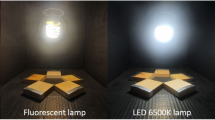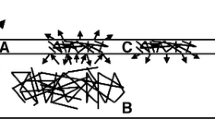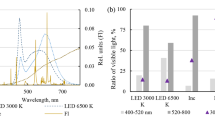Abstract
Although conventional spectrophotometers are well-known to give very accurate and reproducible measuring results of the wood surface colour, the areal resolution of this method is limited due to the fixed aperture size. In this study, the applicability of a colour calibrated flatbed scanner for areal-resolved colorimetry was investigated. For this purpose, the colorimetric values of several wood species calculated from images of a colour calibrated photo-scanner were correlated with those obtained by a conventional spectrophotometer. Further, this method was used to evaluate the discoloration of earlywood and latewood of Siberian larch (Larix sibirica) during Xenon arc exposure as a demonstration of the potential application of this method. In addition, an investigation concerning the possibility of image analysis for the evaluation of the colour change as a consequence of the application of transparent coatings was done. Good correlation among the measured methods could be found by applying relative colour values ΔL* Δa*, Δb* and ΔE*, whereas absolute colour values L*, a* and b* obtained rather weak correlations. The investigation of the relative discoloration of earlywood and latewood of Siberian larch showed a higher amount of discoloration in the earlywood. The investigation concerning the colour change induced by the application of transparent coatings showed that it is possible to evaluate the discoloration by the coating for earlywood and latewood separately. This could be the basis for a more quantitative comparison of quality parameters of coatings like the visual contrast enhancement effect, known as wet-look or “Anfeuerung” of transparent coatings. It was concluded that when evaluating colour changes on wood the use of a calibrated photo-scanner is a valuable addition to conventional spectrophotometry.





Similar content being viewed by others
References
Ayadi N, Lejeune F, Charrier F, Charrier B, Merlin A (2003) Color stability of heat-treated wood during artificial weathering. Holz Roh Werkst 61:221–226
Bianconi F, Fernández A, González E, Saetta SA (2013) Performance analysis of colour descriptors for parquet sorting. Expert Syst Appl 40:1636–1644
Defoirdt N, Wuijtens I, de Boever L, Coppens H, van den Bulcke J, van Acker J (2012) A colour assessment methodology for oak wood. Ann For Sci 69:939–946
Denzler JK, Weidenhiller A, Golser M (2013) Comparison of different approaches for automatic bark detection on log images. Wood Sci Technol 47:749–761
Donato DC, Timme SH (2012) A method for surfacing large log cross-sections for scanning and crossdating. Tree-Ring Res 68:115–119
Forsthuber B, Schaller C, Grüll G (2013) Evaluation of the photo stabilising efficiency of clear coatings comprising organic UV absorbers and mineral UV screeners on wood surfaces. Wood Sci Technol 47:281–297
Hagman O (1997) Multivariate prediction of wood surface features using an imaging spectrograph. Holz Roh Werkst 55:377–382. doi:10.1007/s001070050250
Igathinathane C, Melin S, Sokhansanj S, Bi X, Lim C, Pordesimo L, Columbus E (2009) Machine vision based particle size and size distribution determination of airborne dust particles of wood and bark pellets. Powder Technol 196:202–212
Liu J, Furuno T (2002) The fractal estimation of wood color variation by the triangular prism surface area method. Wood Sci Technol 36:385–397
Meichsner G, Hiesgen R, Esslinger Al, Schottka A (2011) Richtig anfeuern. Farbe und Lack 117(12):24–28
Nyström J, Hagman O (1999) Real-time spectral classification of compression wood in Picea abies. J Wood Sci 45:30–37
Oltean L, Teischinger A, Hansmann C (2008) Wood surface discoloration due to simulated indoor sunlight exposure. Eur J Wood Wood Prod 66:51–56
Patachia S, Croitoru C, Friedrich C (2012) Effect of UV exposure on the surface chemistry of wood veneers treated with ionic liquids. Appl Surf Sci 258:6723–6729
Pintus R, Malzbender T, Wang O, Bergman R, Nachlieli H, Ruckenstein G (2009) Photo repair and 3D structure from flatbed scanners. In: VISAPP 2009—International Conference on Computer Vision Theory and Applications, Lisbon, Portugal, Feb 5–9
Schnabel T, Petutschnigg A (2011) Modelling colour changes of wood for architectural CAD simulations. Comput Aided Des 43:1849–1853
Schnabel T, Zimmer B, Petutschnigg AJ (2009) On the modelling of colour changes of wood surfaces. Eur J Wood Wood Prod 67:141–149
Teischinger A, Zukal ML, Meints T, Hansmann C, Stingl R (2012) Colour characterization of various hardwoods, R. Nemeth, A. Teischinger (eds.). Hardwood Science and Technology. In: The 5th Conference of Hardwood Research and Utilization in Europe, University of West Hungary press, Sopron
Tolvaj L, Faix O (1995) Artificial aging of wood monitored by DRIFT spectroscopy and CIE L*a*b* color measurements. Holzforschung 49:397–404
Weigl M, Kandelbauer A, Hansmann C, Pöckl J, Müller U, Grabner M (2009) Application of natural dyes in the coloration of wood. In: Bechtold T, Mussak R (eds) Handbook of natural colorants. Wiley, New York, pp 277–313
Westland S, Ripamonti C (2004) Computational colour science using MATLAB. Wiley, Hoboken
Acknowledgments
The results presented in this paper are part of the research project “LarchCoat”. Financial support by the Austrian Research Promotion Agency (FFG) as well as companies and associations of the wood and coating industries is gratefully acknowledged.
Author information
Authors and Affiliations
Corresponding author
Rights and permissions
About this article
Cite this article
Forsthuber, B., Illy, A. & Grüll, G. Photo-scanning colorimetry of wood and transparent wood coatings. Eur. J. Wood Prod. 72, 487–495 (2014). https://doi.org/10.1007/s00107-014-0808-6
Received:
Published:
Issue Date:
DOI: https://doi.org/10.1007/s00107-014-0808-6




